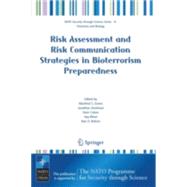
| Introduction to bioterrorism risk assessment | p. 3 |
| Some public health perspectives on quantitative risk assessments for bioterrorism | p. 19 |
| Situational awareness in a bioterror attack via probability modeling | p. 31 |
| The bioterrorism threat | p. 45 |
| Change of mind-set following 9/11 : the few that are already willing to resort to weapons of mass destruction | p. 55 |
| Antimicrobial prophylaxis and providing subacute care in the context of a bioterrorism event : lessons learned from 2001 | p. 67 |
| Detecting and responding to bioterrorism | p. 77 |
| Species-neutral disease surveillance : a foundation of risk assessment and communication | p. 93 |
| Introduction to bioterrorism risk communication | p. 103 |
| Risk communication to health-care workers as a risk reduction measure in bioterrorism | p. 117 |
| Anthrax-euronet and beyond - challenges of scientific research on high risk agents | p. 123 |
| Risk communication and public behavior in emergencies | p. 131 |
| Prevention strategies and promoting psychological resilience to bioterrorism through communication | p. 135 |
| Risk communication and the community response to a bioterrorist attack : the role of an Internet-based early warning system A.K.A. "the informal sector" | p. 163 |
| Information systems for risk communication related to bioterrorism | p. 177 |
| Risk assessment in smallpox bioterrorist aggression | p. 195 |
| Renewal of immunological memory to smallpox : use of new tools yields old results | p. 205 |
| Preparing for a smallpox bioterrorist attack : pulse vaccination as an optimal strategy | p. 219 |
| A priori versus a posteriori risk assessment for bioterror attack | p. 233 |
| Impact of the proliferation of weapons of mass destruction on the stability in the Middle East | p. 235 |
| The role of risk assessment in preparing the health-care system for bioterrorism and natural epidemics | p. 237 |
| Susceptibility of B. Anthracis to various antibacterial agents and their time-kill activity | p. 239 |
| Natural or intentional food contamination? : how can we know? | p. 241 |
| Bioterrorism emergency response : current concepts and controversies | p. 243 |
| Preparedness and response for bioterrorism involving the food supply | p. 245 |
| Risk communication and psychological impact : technological and operational methods of mitigation | p. 247 |
| Table of Contents provided by Blackwell. All Rights Reserved. |
The New copy of this book will include any supplemental materials advertised. Please check the title of the book to determine if it should include any access cards, study guides, lab manuals, CDs, etc.
The Used, Rental and eBook copies of this book are not guaranteed to include any supplemental materials. Typically, only the book itself is included. This is true even if the title states it includes any access cards, study guides, lab manuals, CDs, etc.